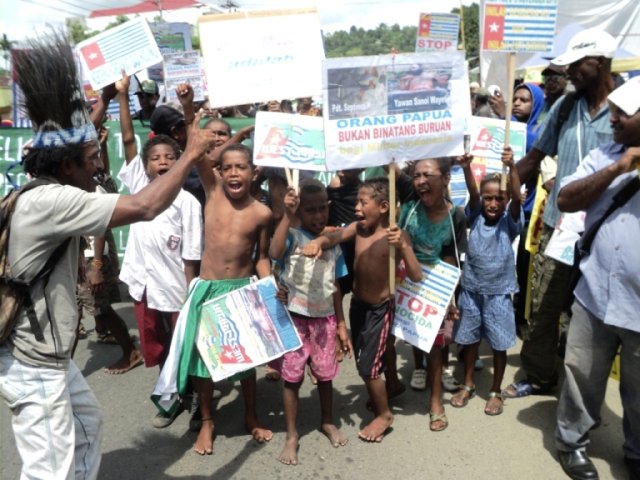
Maire Leadbeater is a spokesperson for the Indonesia Human Rights Committee (Auckland). She recently returned from West Papua, a nation that has faced repression since its occupation by Indonesia in 1963. She spoke to Green Left Weekly's Ash Pemberton.
* * *
Can you give your impressions of West Papuan society under Indonesian occupation?
Two things stand out when you first arrive in [the capital] Jayapura, the extent of the militarisation and the dominance of the migrant community in business and everyday life.
I quickly gave up the attempt to count the number of military and police bases — there were just too many. Policemen and soldiers seemed to be everywhere.
In the rural areas it was the same. I visited a small village of perhaps 30 or 40 houses with no electricity, phone, running water or transport service, but its very own TNI [Indonesian army] post keeping track of everyone's movements.
In Jayapura, the immaculate Brimob (special police mobile brigade) base was particularly formidable — with five tank-like vehicles and one shiny new anti-terror vehicle equipped with water cannon.
During my visit I saw the vehicles deployed, waiting in readiness in central Jayapura while a 50 or 60-strong “reject autonomy” demonstration took place at the provincial parliament building.
Fortunately, on this occasion there were no arrests, but it would be hard to overestimate the courage of those who gather knowing that their actions are always being monitored.
The “intel” will be around close by riding an ojek (motor bike taxi) or “selling” food on a stall.
I read all the time about the marginalisation of the Papuan community but it was another thing to see the reality — the Papuan women selling their produce or their beautiful craftwork on the pavement outside the glossy Western-style supermarket.
At the Yotefa market near Abepura, migrants seemed to have cornered the market for every kind of commodity and are even, to the dismay of the Papuans, selling penang (or betel nut), a treasured part of Papuan culture.
The Merauke Intergrated Food and Energy Estate (MIFEE) is a proposed 1.6 million hectare agribusiness that has been imposed on the people of Merauke on the south coast. What did you learn about what's going on in Merauke?
Merauke was a favoured area at the height of the transmigration era, but now is being asked to ready itself for an influx of unbelievable numbers.
The current population stands at around 300,000, but figures for the workers needed for MIFEE are up to 4-5 million.
The World Wildlife Fund has mapped the area and documented the Papuan sacred sites, the paths for migratory birds, the water catchments, the fragile savannah areas, the virgin forests and the mangroves.
There is growing opposition, especially from Malin tribal leaders, many Church leaders and younger activists.
If you are familiar with the problem of deforestation in West Papua you will know how the process of consultation works — find a compliant member of a tribe, get documents signed and beat back criticism later.
Has increased media attention this year given the Papuan movement a boost?
Papuans are very aware of the impact of the “torture video”. Media attention has helped, although Indonesia's latest ruse of putting soldiers on trial for a different episode of beating to the one featured in the latest YouTube exposure is cynical.
I was told that what we get to see is only a fraction of the abuses that take place away from any scrutiny in the highland areas.
New Zealand media coverage is still far too low. Radio NZ International is an honourable exception. How come a demonstration of some 20,000 … does not rate mention in our mainstream media?
Papuan leaders are currently exerting a huge effort to achieve unity and I was told that this work is now paying off. The two major groupings (“Coalition” and “Consensus”) have recently reached an agreement to work together.
You have been campaigning in solidarity with West Papua for a long time. What do Papuans see as priorities for the solidarity movement in countries like Australia and New Zealand?
Because of the isolation factor, some Papuans are unrealistic in their expectations of what may be forthcoming from our governments, and it was not easy or fun to try to give an explanation of the interests and allegiances that drive foreign policy in Canberra and Wellington.
However, accounts of our demonstrations, especially flag-raising events, met with very warm approval.
Recently released from his arduous detention for raising the flag in 2004, Yusak Pakage was effusive in his thanks for all who campaigned on his behalf. It was very humbling.
In New Zealand, we have had some success with campaigns on issues that directly link West Papua to New Zealand: for example, the import to NZ of kwila (merbau) for decking and furniture; the NZ Government's Super Fund investment in the Freeport-McMoran gold and copper mine; and our training of Indonesian military and police.
NZ's program for training the West Papuan police in “community policing” does not seem to be popular. I put the question to a group of students one evening. One reply seemed to capture the mood: a young man said a few words in Indonesian first and then in English: "New Zealand go to hell!"
A priority must be to break down the imposed isolation. The “hidden” conflict is not quite so hidden now, so we must keep up the momentum.

Comments
jabuzzoffh123 replied on Permalink
Anonymous replied on Permalink